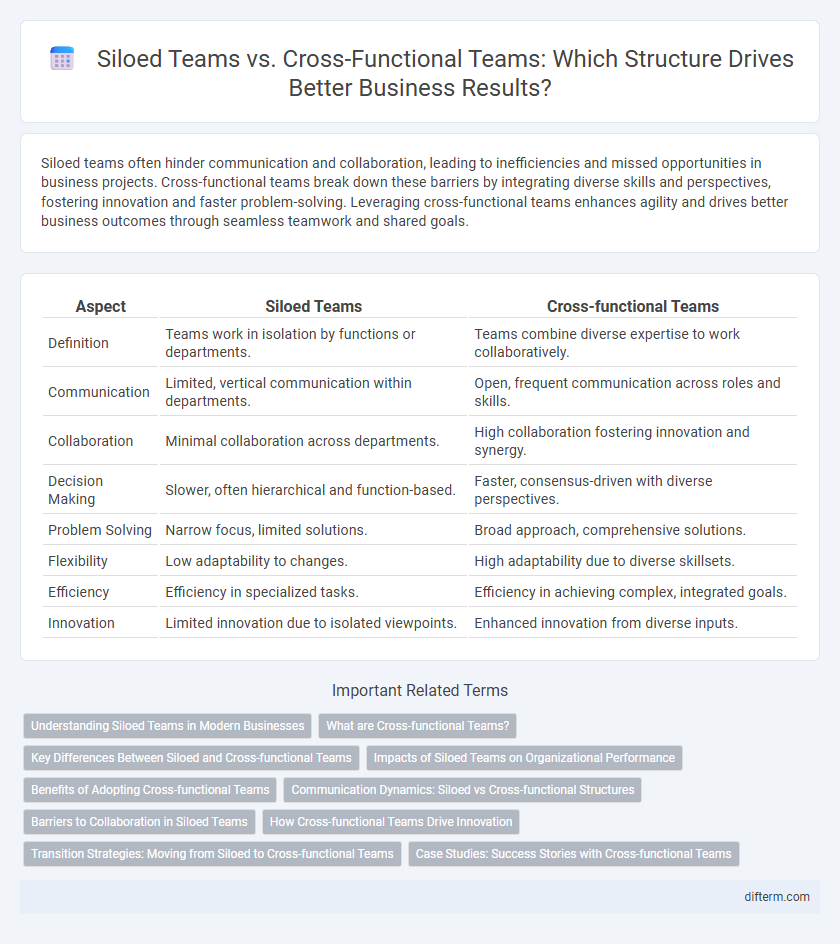Siloed teams often hinder communication and collaboration, leading to inefficiencies and missed opportunities in business projects. Cross-functional teams break down these barriers by integrating diverse skills and perspectives, fostering innovation and faster problem-solving. Leveraging cross-functional teams enhances agility and drives better business outcomes through seamless teamwork and shared goals.
Table of Comparison
| Aspect | Siloed Teams | Cross-functional Teams |
|---|---|---|
| Definition | Teams work in isolation by functions or departments. | Teams combine diverse expertise to work collaboratively. |
| Communication | Limited, vertical communication within departments. | Open, frequent communication across roles and skills. |
| Collaboration | Minimal collaboration across departments. | High collaboration fostering innovation and synergy. |
| Decision Making | Slower, often hierarchical and function-based. | Faster, consensus-driven with diverse perspectives. |
| Problem Solving | Narrow focus, limited solutions. | Broad approach, comprehensive solutions. |
| Flexibility | Low adaptability to changes. | High adaptability due to diverse skillsets. |
| Efficiency | Efficiency in specialized tasks. | Efficiency in achieving complex, integrated goals. |
| Innovation | Limited innovation due to isolated viewpoints. | Enhanced innovation from diverse inputs. |
Understanding Siloed Teams in Modern Businesses
Siloed teams in modern businesses operate independently, often resulting in limited communication and collaboration between departments, which hampers innovation and efficiency. This isolation can create redundancies, slow decision-making, and reduce the organization's ability to respond quickly to market changes. Understanding the impact of siloed teams helps businesses identify the need for integrating cross-functional collaboration to improve overall performance.
What are Cross-functional Teams?
Cross-functional teams are groups composed of members from different departments or areas of expertise working collaboratively to achieve common business objectives. These teams enhance innovation and problem-solving by integrating diverse skills and perspectives, leading to more efficient project completion and improved organizational agility. By breaking down traditional silos, cross-functional teams foster better communication and alignment across business functions.
Key Differences Between Siloed and Cross-functional Teams
Siloed teams operate independently within departments, leading to limited communication and duplicated efforts, whereas cross-functional teams integrate diverse expertise from various departments to enhance collaboration and innovation. Siloed teams often face barriers to sharing information, resulting in slower decision-making processes, while cross-functional teams accelerate problem-solving by leveraging collective knowledge. The key difference lies in their structural approach: siloed teams emphasize specialization within boundaries, and cross-functional teams prioritize holistic, goal-oriented teamwork across organizational lines.
Impacts of Siloed Teams on Organizational Performance
Siloed teams create barriers in communication and collaboration, leading to reduced efficiency and slower decision-making in organizations. This fragmentation often results in duplicated efforts, misaligned goals, and decreased innovation, negatively impacting overall productivity and competitive advantage. Organizations with siloed teams frequently experience lower employee engagement and higher operational costs due to inefficient resource utilization.
Benefits of Adopting Cross-functional Teams
Cross-functional teams enhance collaboration by integrating diverse expertise, leading to faster problem-solving and innovation. These teams improve communication across departments, reducing bottlenecks and aligning goals with overall business strategy. Embracing cross-functional structures boosts agility, increases employee engagement, and accelerates project delivery times.
Communication Dynamics: Siloed vs Cross-functional Structures
Siloed teams often experience limited communication flows, resulting in isolated knowledge and slower decision-making processes, which hinder overall organizational agility. Cross-functional teams enhance communication dynamics by fostering direct collaboration across departments, enabling faster problem-solving and innovation through shared expertise. Effective cross-functional communication breaks down barriers, aligning goals and improving transparency throughout project lifecycles.
Barriers to Collaboration in Siloed Teams
Siloed teams face significant barriers to collaboration due to isolated communication channels and limited information sharing, resulting in redundant efforts and reduced innovation. These teams often struggle with misaligned goals and lack of transparency, which hampers decision-making and slows project momentum. Breaking down silos requires structured knowledge management systems and leadership that promotes a culture of open collaboration.
How Cross-functional Teams Drive Innovation
Cross-functional teams drive innovation by combining diverse expertise, enabling faster problem-solving and creative solutions that siloed teams often miss due to limited perspectives. This collaborative structure fosters continuous knowledge sharing, accelerates decision-making, and adapts more swiftly to market changes. Companies leveraging cross-functional teams report higher innovation rates and improved product development cycles, boosting competitive advantage.
Transition Strategies: Moving from Siloed to Cross-functional Teams
Transitioning from siloed teams to cross-functional teams requires implementing structured communication channels and fostering a culture of collaboration across departments. Companies should invest in team-building activities and cross-training programs to break down barriers and enhance shared goals. Utilizing project management tools that support transparency and accountability facilitates smoother integration and improved collective performance.
Case Studies: Success Stories with Cross-functional Teams
Case studies reveal that cross-functional teams significantly enhance innovation and problem-solving by integrating diverse expertise from marketing, engineering, and sales departments. Companies like Google and Spotify demonstrate accelerated project timelines and higher product quality through collaborative teamwork that breaks down silos. Metrics from these case studies show increased employee engagement and faster decision-making processes compared to siloed team structures.
Siloed Teams vs Cross-functional Teams Infographic

 difterm.com
difterm.com